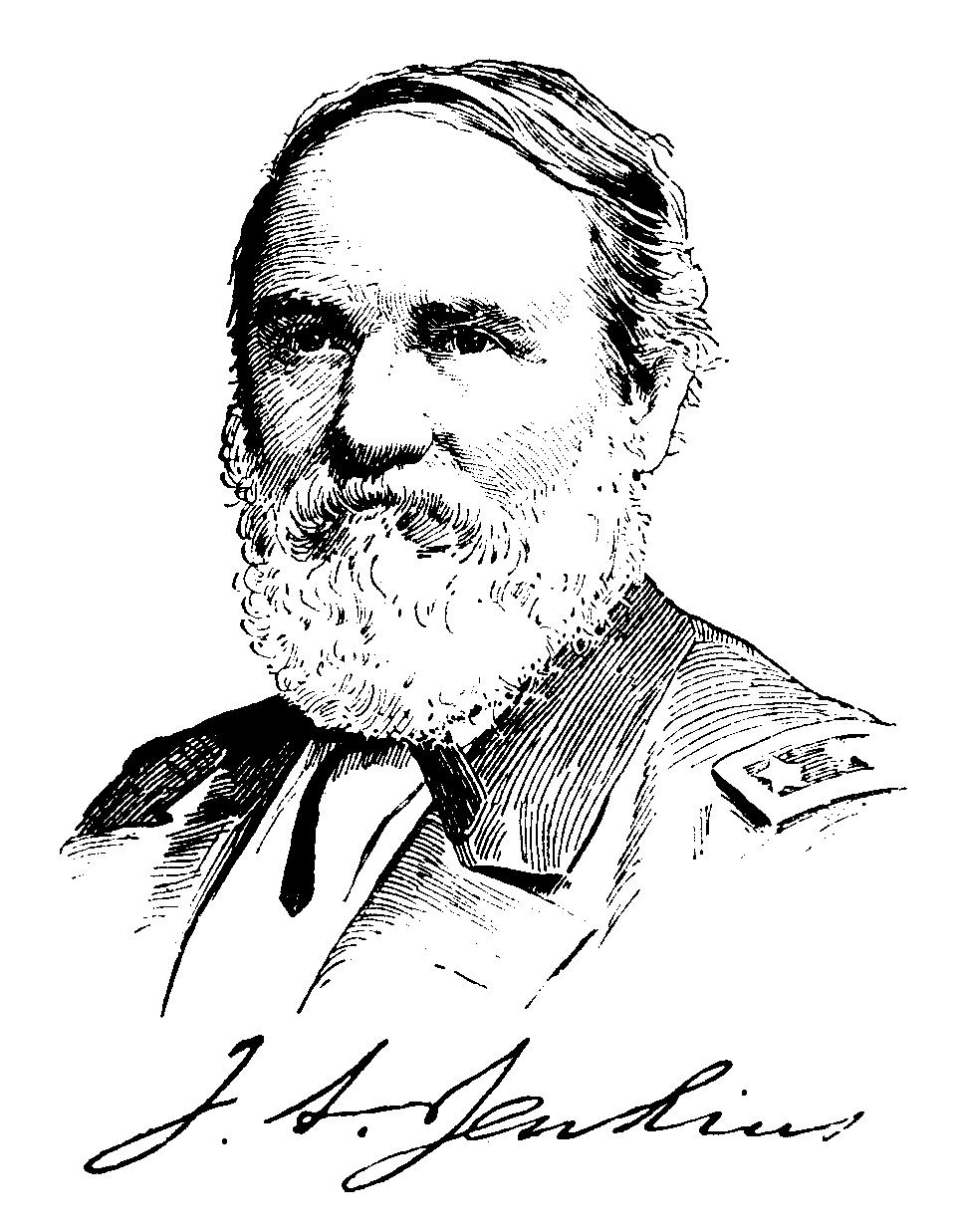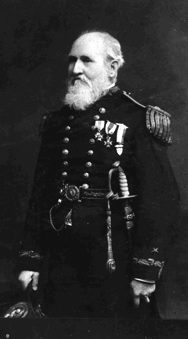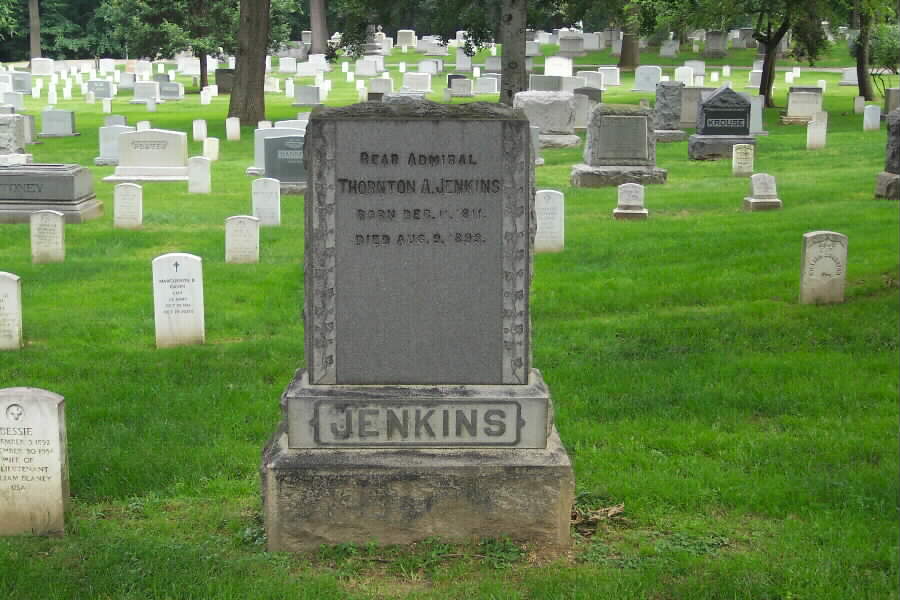Thornton Alexander Jenkins, naval officer, born in Orange county, Virginia, 11 December, 1811.
He was prepared for college, but entered the Navy as a Midshipman, 1 November, 1828, and in the following spring sailed on the “Natchez” for Cuba, where he performed hazardous services in breaking up nests of pirates. In 1831 he assisted in suppressing Nat Turner’s negro insurrection in Virginia. He was commissioned as Lieutenant on 9 December, 1839, and from 1834 till 1842 was employed as assistant to Professor Ferdinand R. Hassler on the coast survey.
In 1845 he was sent to Europe to examine lighthouse systems and other aids to navigation, but returned in about a year to prevent being detained in case war should occur with Great Britain. In 1846 he made an elaborate report of the illuminants, towers, light-ships, buoys, beacons, and other adjuncts of the light-house service in England, France, and other European countries.
During the Mexican war he served as executive officer of the sloop ” German-town,” and afterward in command of the store-ship “Relief,” and of the supply and hospital station on Salmadena island. In the capture of Tuspan and Tobasco he commanded the landing parties from the “Germantown.” In 1848-’51, when Professor Alexander D. Bache was superintendent of the coast survey, he was engaged, while in command of the schooner “John Y. Mason” and the steamers “Jefferson” and “Corwin ” in meteorological and hydrographic observations, and in taking deep-sea temperatures in the Gulf stream. The last-named vessel was built from his designs and under his superintendence.
In October, 1852, he was appointed Naval Secretary to the light-house beard, having for two years previous served as secretary to the temporary board. He was promoted commander on 14 September, 1855, and given the “Preble” in the Paraguayan expedition of 1858-‘9. Immediately on his return he was ordered to the Caribbean sea in search of the filibuster William Walker, and thence to Vera Cruz, Mexico, where he took part in the capture of the “Miramon” and “Marquis of Havana,” which he convoyed to New Orleans. In conjunction with Captain William F. Smith he was instrumental in saving the forts at Key West and Dry Tortugas from falling into the hands of an expedition that was sent from New Orleans before the civil war was openly begun.
In February, 1861, he was again appointed Secretary to the Light-House Board, and during that year performed delicate and secret, services at the request of President Lincoln, until he was attacked with serious illness in November. He was promoted Captain, 16 July, 1862, and was the senior officer at the repulse of the enemy at Coggin’s Point, James river, and at the attack on the United States forces at City Point in August, 1862. In the autumn of 1862 he was engaged in blockading Mobile and its approaches in command of the “Oneida,” of the Western Gulf blockading” squadron. He was fleet-captain and chief of staff of Farragut’s squadron in the Mississippi, commanding the “Hartford” at the passing of the Port Hudson and Grand Gulf batteries, He had encounters with the enemy at various points on the river, and at the capture of Port Hudson was in chief command of the naval forces, Admiral Farragut having gone some time before on necessary business to New Orleans. In the blockade of Mobile in 1864 he commanded the “Richmond” and the 2d division of Admiral Farragut’s fleet, and he was left in command in Mobile bay till February, 1865, when he was ordered to the James river, and remained there until after the surrender of General Lee.
He then went to the Ohio and Mississippi rivers to investigate seamen’s bounty claims, and was president of a board that awarded a large aggregate sum to enlisted men and their families, he was commissioned as Commodore on 25 July, 1866. From 1865 till he resigned the office on the change of administration in 1869. He was Chief of the Board of Navigation, and then Secretary of the Light-House board till 1871, being promoted rear-admiral on 13 July, 1870. Afterward he commanded the naval forces on the Asiatic station until he was retired on 12 December, 1873. He had charge of the exhibit of the navy department at the Centennial exhibition at Philadelphia in 1876.
He died on 2 August 1893 and was buried in Section 1 of Arlington National Cemetery with full military honors.
His grandson, Stanley P. Converse, Colonel, United States Army, is also buried in Arlington National Cemetery.
REAR ADMIRAL JENKINS’S FUNERAL
WASHINGTON, August 12, 1893 – The funeral of Rear Admiral Jenkins, United States Navy, retired, took place this afternoon. It was conducted without military display and with unusual privacy for the obsequies of one so prominent as the deceased officer. Eight enlisted men from the receiving ship Dale acted as body bearers. At 3 o’clock brief services were held at the Jenkins residence and the interment was at the Arlington National Cemetery.
Secretary Herbert has written a very eulogistic letter concerning the dead officer to the latter’s son.
JENKINS, THORNTON A
- ADMIRAL USN
- VETERAN SERVICE DATES: Unknown
- DATE OF DEATH: 08/09/1893
- DATE OF INTERMENT: Unknown
- BURIED AT: SITE 43-D
ARLINGTON NATIONAL CEMETERY
JENKINS, ALICE THORNTON D/O THORNTON A
- DATE OF DEATH: 06/30/1935
- DATE OF INTERMENT: 07/02/1935
- BURIED AT: SECTION WEST SITE 43-C
ARLINGTON NATIONAL CEMETERY - DAUGHTER OF TA JENKINS – REAR ADM USN
JENKINS, FRANCIS T S/O THORNTON A
- DATE OF DEATH: 06/15/1917
- DATE OF INTERMENT: Unknown
- BURIED AT: SECTION LOT 4
- ARLINGTON NATIONAL CEMETERY
- SON OF TA JENKINS – REAR ADMR USN

Michael Robert Patterson was born in Arlington and is the son of a former officer of the US Army. So it was no wonder that sooner or later his interests drew him to American history and especially to American military history. Many of his articles can be found on renowned portals like the New York Times, Washingtonpost or Wikipedia.
Reviewed by: Michael Howard


